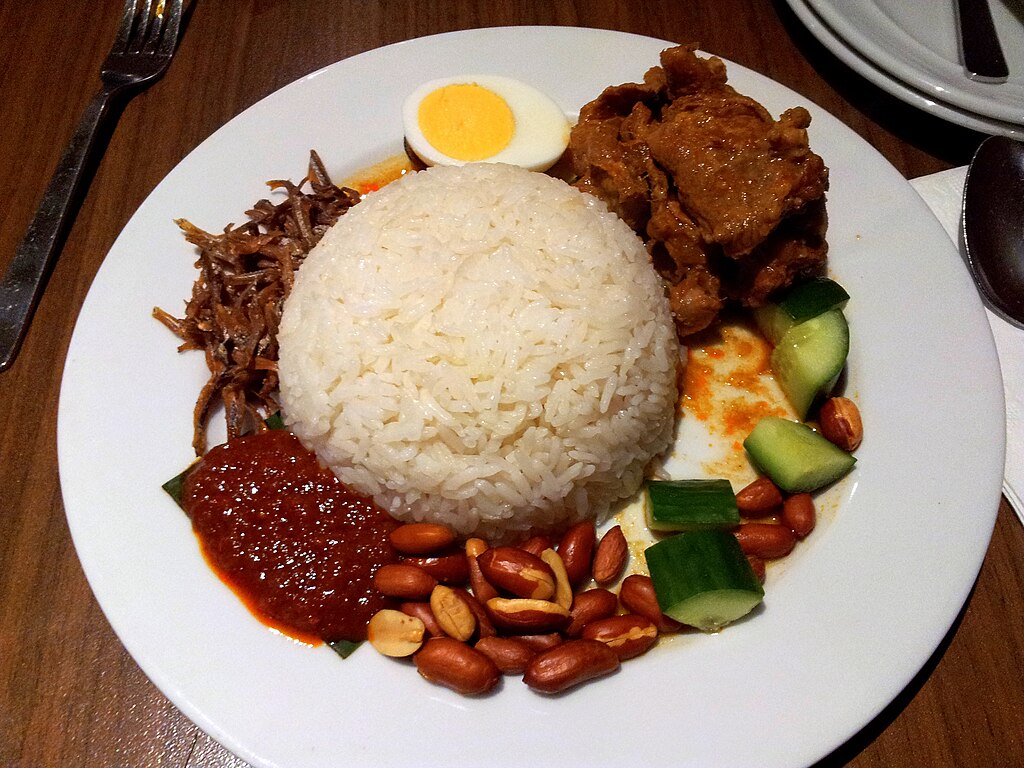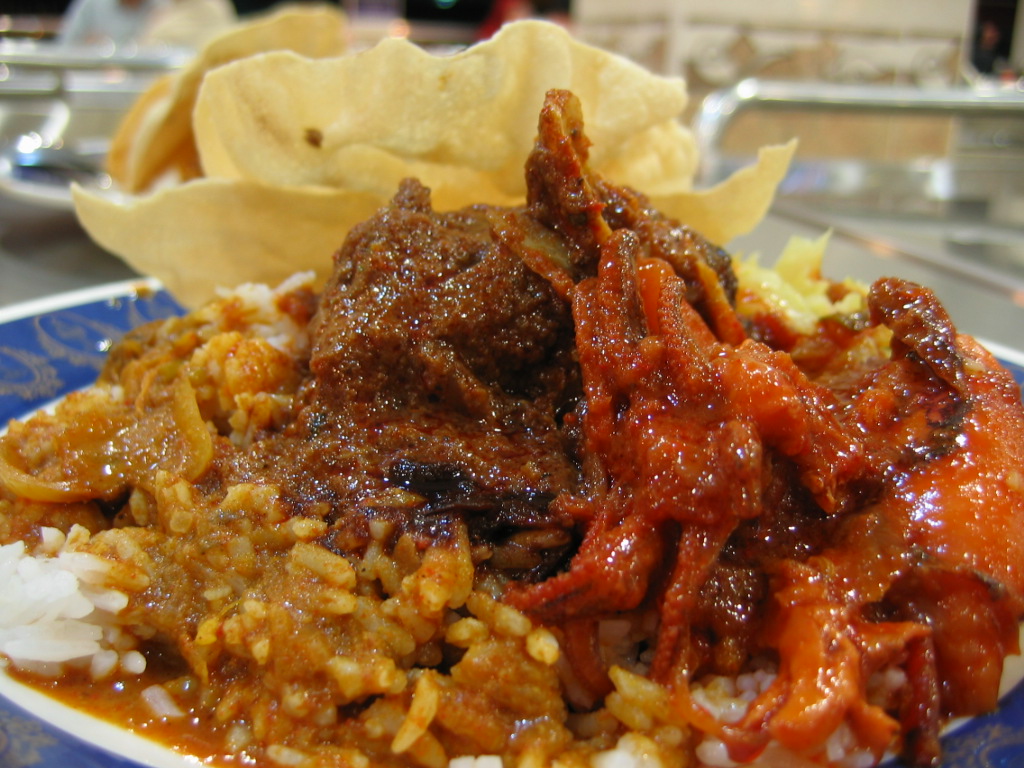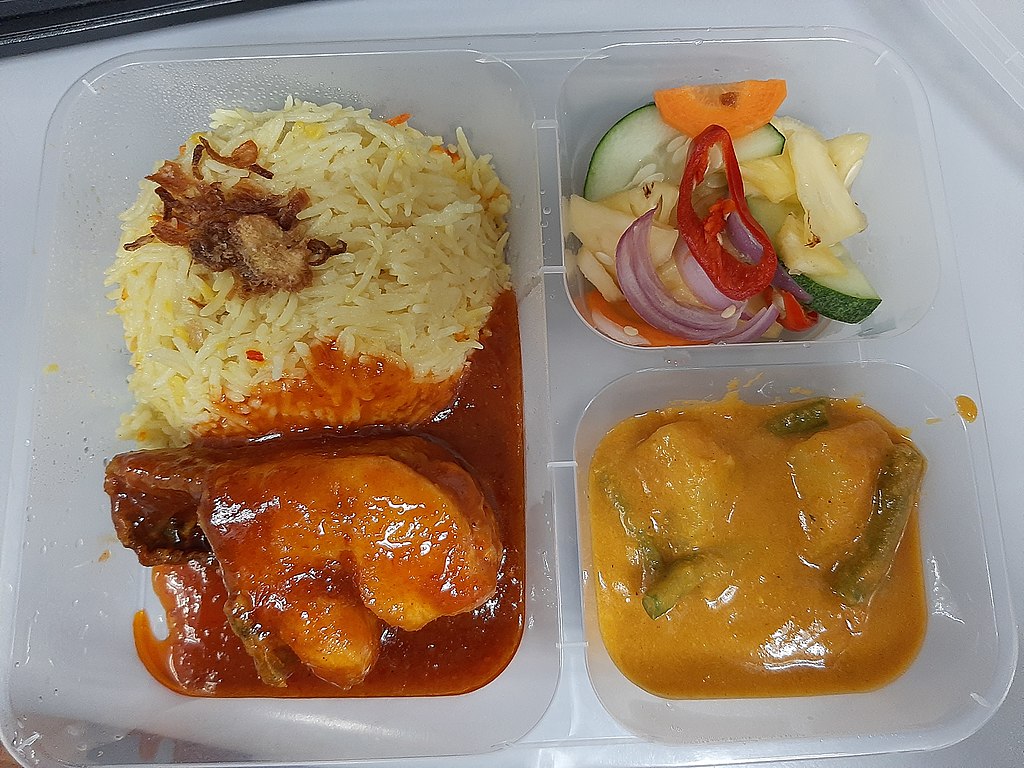Table of Contents
Toggle10 Malaysian Rice Dishes that You Must Try in Malaysia
If there’s one thing you’ll never run out of (or get tired of) in Malaysia, it’s rice — steamed, fried, wrapped in leaves, soaked in coconut milk, dyed blue, you name it. Rice is the main event here. Every culture in Malaysia has its own way of making it shine, from spicy nasi lemak to royal-style nasi kerabu and festive nasi kunyit.
Whether you’re eating with your hands at a roadside stall or sitting down to a feast, rice is at the heart of it all. So if you’re new to Malaysian food (or just looking to expand beyond chicken rice), here are 10 rice dishes you’ve absolutely got to try.
You may also like:
1. Nasi Lemak

Arguably the most popular dish in Malaysia, nasi lemak is rice cooked in coconut milk, and served with sambal (chili paste), fried anchovies, peanuts, boiled egg, and cucumber slices. Those are the essential accompaniments to this dish, but you can also add on chicken, beef, or any other sides you prefer.
We usually have it for breakfast. Yah, ’cause we crazy like that.
The breakfast version is smaller in portion, and is often wrapped in banana leaves and laminated paper. It can be found in almost any cafe, restaurant, and street vendor in the morning. But now it’s also available on the menus of fancy restaurants — to be eaten at any time of the day (or night).
2. Nasi Kerabu

Nasi kerabu can easily be recognized by its quirky blue color. The blue tinge comes from butterfly pea flowers that are boiled together with the rice. It’s done only for aesthetic purpose and doesn’t change the taste or smell of the rice.
Nasi kerabu is typically served with raw vegetables such as finely shredded cabbage, long beans, and bean sprouts, tossed with grated coconuts and fresh herbs. Other sides may include salted eggs, sambal, stuffed green chilis, fermented fish paste, and fish crackers. It also goes very well with ayam percik (roasted chicken with a thick coating of coconut-based gravy). Very popular in the east coast of Peninsular Malaysia.
3. Nasi Dagang

Like nasi kerabu, nasi dagang is also popular in the east coast of Peninsular Malaysia, particularly in the states called Kelantan and Terengganu. It is made from husked red rice (or the combination of jasmine and glutinous white rice) that is steamed in coconut milk.
Nasi dagang is usually accompanied by spicy fish curry, acar (pickled vegetables), hard-boiled eggs, sambal, and fish crackers.
Commonly served for breakfast.
4. Nasi Kandar

Nasi kandar is a dish that is often associated with Penang and the Indian Muslim community. Essentially, it’s just white rice with a simple combination of vegetables, meats, and curries, but it’s a comfort food for many. And these people are willing to make the journey to Penang just to find the best nasi kandar.
In the old days, the vendors would go around carrying the rice and its condiments in a basket attached to a long pole (kandar) that they put over their shoulders — hence the name.
5. Nasi Minyak

Literally meaning ‘oil rice’, nasi minyak is a dish that is usually only served at Malay weddings or special occasions. You’d have to be very lucky to get ahold of this — it’s rarely sold in restaurants.
The rice is cooked with ghee oil or clarified butter, sauteed onion and an assortment of spices and stock to give it that special taste and aroma. It is commonly paired with acar, spicy tomato chicken, and beef rendang.
6. Nasi Ayam

Nasi ayam is rice cooked in chicken stock and seasoned with ginger. It was first brought to Malaysia by the Chinese traders from the Hainan province. Even to this day, the Hainanese chicken rice remains the most popular version in Malaysia. It is served with boiled and steamed chicken, a lot of ginger and garlic, soy sauce, red chili sauce, cucumber slices, sometimes bean sprouts, and a bowl of chicken broth.
After being steeped in boiling water till it is fully cooked, the chicken is soaked in cold water to make sure that it retains its tenderness. Alternatively, the chicken can also be roasted.
The Malay people has also come up with their own version, in which the rice is cooked with star anise, and the chicken fried in spices.
7. Nasi Goreng

Nasi goreng simply translates to fried rice. But in Malaysia, it’s not as simple as that. Nasi goreng can take on many forms. In fact, every Malaysian household tends to have its own fried rice recipe. Click here to see the 10 most popular types of nasi goreng that you can find in Malaysia.
The great thing about it is that it doesn’t require much ingredient, effort or cooking skill. Almost anyone can produce a sumptuous meal of nasi goreng using only leftovers and overnight rice.
8. Nasi Beriani Gam

Nasi beriani gam is the Malaysian take on the famous Indian biryani. Popular in the southern state of Johor, it consists of fluffy basmathi rice cooked with spices, served with your choice of meat (usually mutton, beef, or chicken), hard-boiled eggs, and some vegetables.
But unlike regular biryani, beriani gam rice is cooked together with the meat instead of separately. They are slow-cooked on low heat, with the pot sealed to trap the steam, resulting in fall-off-the-bone tender meat and flavorful rice.
9. Nasi Kunyit

Literally meaning “turmeric rice”, nasi kunyit is often prepared to celebrate special events such as a wedding, graduation, the birth of a baby, or the arrival of an important guest. So, if you go to someone’s house and they cook this, you should feel very special!
Nasi kunyit typically uses glutinous rice and is eaten with meat curry or rendang.
10. Banana-Leaf Rice

Eating at a banana-leaf restaurant is, in itself, a cool experience. Instead of plates, food is served on banana leaves. This style of eating originated from Southern India, but has become popular in Malaysia as well.
The white rice is served with a variety of side dishes and curries. This can be with or without meat. Trying to get the curries to stay on the flat banana leaf requires some skill, so make sure you don’t pour too much liquid on your food if you don’t want it to drip down the table and onto your lap.
Traditionally, banana-leaf rice is eaten with fingers instead of cutlery. And at the end of the meal, it is considered a courtesy to fold the banana leaf (front fold indicating satisfaction, and backfold indicating displeasure).
Have you tried any of these rice dishes before? Which one is your favorite? Comment below.
Check out these other posts:
- 10 Types of Nasi Goreng (Fried Rice) that You Must Try in Malaysia
- 10 Types of Noodle Dishes that You Must Try in Malaysia
- 10 Must-Try Malaysian Desserts
- 10 Must-Try Malaysian Drinks
- 10 Savory Snacks that You Must Try in Malaysia
Pingback:10 Traditional Malaysian Desserts to Satisfy Your Sweet Tooth – Ummi Around Malaysia
Pingback:10 Things You Must NOT Do When Visiting Malaysia – Ummi Around Malaysia
Pingback:10 Types of Nasi Goreng (Fried Rice) That You Must Try in Malaysia – Ummi Around Malaysia